Official California Deed Document
A California Deed form is a legal document used to transfer ownership of real property from one party to another. This form plays a crucial role in ensuring that the transfer is recognized by the state and protects the rights of both the buyer and seller. Understanding the different types of deeds and their specific purposes can help you navigate the property transfer process with confidence.
Open My Deed Now
